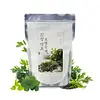What's inside
What's inside
 Key Ingredients
Key Ingredients

 Benefits
Benefits

 Concerns
Concerns

 Ingredients Side-by-side
Ingredients Side-by-side

Diatomaceous Earth
AbrasiveGlucose
HumectantAlgin
MaskingCI 77231
Cosmetic ColorantKaolin
AbrasiveTrehalose
HumectantBetaine
HumectantChlorella Vulgaris Powder
Skin ConditioningXylitol
HumectantCentella Asiatica Extract
CleansingMelaleuca Alternifolia Leaf Extract
PerfumingPanthenol
Skin ConditioningAllantoin
Skin ConditioningMadecassoside
AntioxidantAsiaticoside
AntioxidantAsiatic Acid
Skin ConditioningMadecassic Acid
Skin ConditioningDextrin
AbsorbentSodium Dehydroacetate
PreservativeTetrasodium Pyrophosphate
BufferingCarthamus Tinctorius Flower Extract
Skin ConditioningGardenia Florida Fruit Extract
Skin ConditioningSodium Hyaluronate
HumectantWater
Skin ConditioningGlycerin
HumectantButylene Glycol
Humectant1,2-Hexanediol
Skin ConditioningLactobacillus Ferment
Skin ConditioningAlthaea Rosea Flower Extract
Skin ConditioningNymphaea Caerulea Flower Extract
Skin ConditioningSwertia Japonica Extract
Skin ConditioningDiatomaceous Earth, Glucose, Algin, CI 77231, Kaolin, Trehalose, Betaine, Chlorella Vulgaris Powder, Xylitol, Centella Asiatica Extract, Melaleuca Alternifolia Leaf Extract, Panthenol, Allantoin, Madecassoside, Asiaticoside, Asiatic Acid, Madecassic Acid, Dextrin, Sodium Dehydroacetate, Tetrasodium Pyrophosphate, Carthamus Tinctorius Flower Extract, Gardenia Florida Fruit Extract, Sodium Hyaluronate, Water, Glycerin, Butylene Glycol, 1,2-Hexanediol, Lactobacillus Ferment, Althaea Rosea Flower Extract, Nymphaea Caerulea Flower Extract, Swertia Japonica Extract
Diatomaceous Earth
AbrasiveGlucose
HumectantCI 77231
Cosmetic ColorantAlgin
MaskingTetrasodium Pyrophosphate
BufferingMagnesium Oxide
AbsorbentArtemisia Caruifolia Powder
AbrasiveCellulose Gum
Emulsion StabilisingChlorella Vulgaris Powder
Skin ConditioningTheobroma Cacao Fruit Powder
Skin ConditioningArtemisia Princeps Leaf Extract
Skin ConditioningHouttuynia Cordata Powder
Skin ConditioningSolanum Melongena Fruit Extract
Skin ConditioningCentella Asiatica Extract
CleansingCamellia Sinensis Leaf
PerfumingCamellia Sinensis Leaf Powder
ExfoliatingCamellia Sinensis Leaf Extract
AntimicrobialPortulaca Oleracea Extract
Skin ConditioningOpuntia Coccinellifera Flower Extract
Skin ConditioningAloe Barbadensis Leaf Juice Powder
Skin ConditioningPinus Densiflora Leaf Extract
AntimicrobialCamellia Japonica Leaf Extract
Skin ConditioningPaeonia Lactiflora Extract
AstringentGlycyrrhiza Glabra Root Powder
Skin ConditioningAllantoin
Skin ConditioningBetaine
HumectantKaolin
AbrasiveMaltodextrin
AbsorbentDehydroacetic Acid
PreservativeDiatomaceous Earth, Glucose, CI 77231, Algin, Tetrasodium Pyrophosphate, Magnesium Oxide, Artemisia Caruifolia Powder, Cellulose Gum, Chlorella Vulgaris Powder, Theobroma Cacao Fruit Powder, Artemisia Princeps Leaf Extract, Houttuynia Cordata Powder, Solanum Melongena Fruit Extract, Centella Asiatica Extract, Camellia Sinensis Leaf, Camellia Sinensis Leaf Powder, Camellia Sinensis Leaf Extract, Portulaca Oleracea Extract, Opuntia Coccinellifera Flower Extract, Aloe Barbadensis Leaf Juice Powder, Pinus Densiflora Leaf Extract, Camellia Japonica Leaf Extract, Paeonia Lactiflora Extract, Glycyrrhiza Glabra Root Powder, Allantoin, Betaine, Kaolin, Maltodextrin, Dehydroacetic Acid
Ingredients Explained
These ingredients are found in both products.
Ingredients higher up in an ingredient list are typically present in a larger amount.
Algin is brown algae. Algae is an informal term for a group of aquatic organisms that can photosynthesize. It is estimated there are at least 30,000 types of Algae.
Algae contains antioxidants. Antioxidants help fight free-radicals. Free-radicals are molecules that may damage your skin cells, such as pollution.
Allantoin is a soothing ingredient known for its protective and moisturizingg properties. Because of this, it is often added to products with strong active ingredients.
Studies show higher concentrations of this ingredient can promote wound healing.
Though it can be derived from the comfrey plant, allantoin is produced synthetically for cosmetic products to ensure purity.
Learn more about AllantoinBetaine is a common humectant (a substance that promotes retention of moisture). It's known to be gentle on the skin and can help balance hydration.
This ingredient is best for improving hydration and soothing irritated skin. Studies also show it helps even out skin tone.
Fun fact: Betaine is naturally created in the skin and body. The kind found within cosmetic products can be either plant-derived or synthetic.
Another name for betaine is trimethylglycine.
Learn more about BetaineCentella Asiatica Extract (Centella) is derived from an herb native to Southeast Asia. It is famous for its anti-inflammatory and soothing properties.
Centella is rich in antioxidants and amino acids, such as Madecassic Acid and Asiaticoside.
Studies show the compounds in centella help with:
The combination of all these properties makes centella effective at soothing, hydrating, and protecting the skin.
Other great components of centella include Vitamin A, vitamin C, several B vitamins, and Asiatic Acid.
Fun fact: Centella has been used as a medicine and in food for many centuries. As a medicine, it is used to treat burns, scratches, and wounds.
Learn more about Centella Asiatica ExtractWe don't have a description for Chlorella Vulgaris Powder yet.
We don't have a description for CI 77231 yet.
Diatomaceous Earth is an exfoliant.
Glucose is a simple sugar and is the most important source of energy in all organisms.
In skincare, glucose is used to hydrate the skin. It also acts as a prebiotic for our natural biome.
Glucose is hydrating due to its humectant property. As a humectant, glucose draws moisture from the air and from deeper levels in the skin.
Our skin contains many sugars that act as prebiotics and help strengthen our natural microbiome. Having a healthy microbiome helps protect our skin from harmful bacteria and other contaminants.
Studies show glucose may help with fading discoloration and pigmentation. This is because our skin metabolizes glucose into lactic acid. Lactic acid is an AHA that helps exfoliate the top layer of skin.
Learn more about GlucoseKaolin is a clay. It is used for oil control and to help minimize pores. Like other clays, kaolin has the ability to absorb excess sebum or oil. This can help clean out pores and mattify the skin.
Some types of kaolin may have exfoliating properties. When water is added to kaolin, it becomes a paste with small abrasive particles.
Most kaolin is a white color, but may be pink/orange/red depending on where it comes from.
The name 'kaolin' comes from a Chinese village named 'Gaoling'. Kaolin clay comes from rocks rich in kaolinite. Kaolinite, the mineral, has a silicate layered structure. Kaolinite is formed from chemical weathering of aluminum siilicate minerals.
Besides skincare, kaolin is commonly used to make glossy paper, in ceramics, toothpaste, and as medicine to soothe stomach issues.
Learn more about KaolinWe don't have a description for Tetrasodium Pyrophosphate yet.